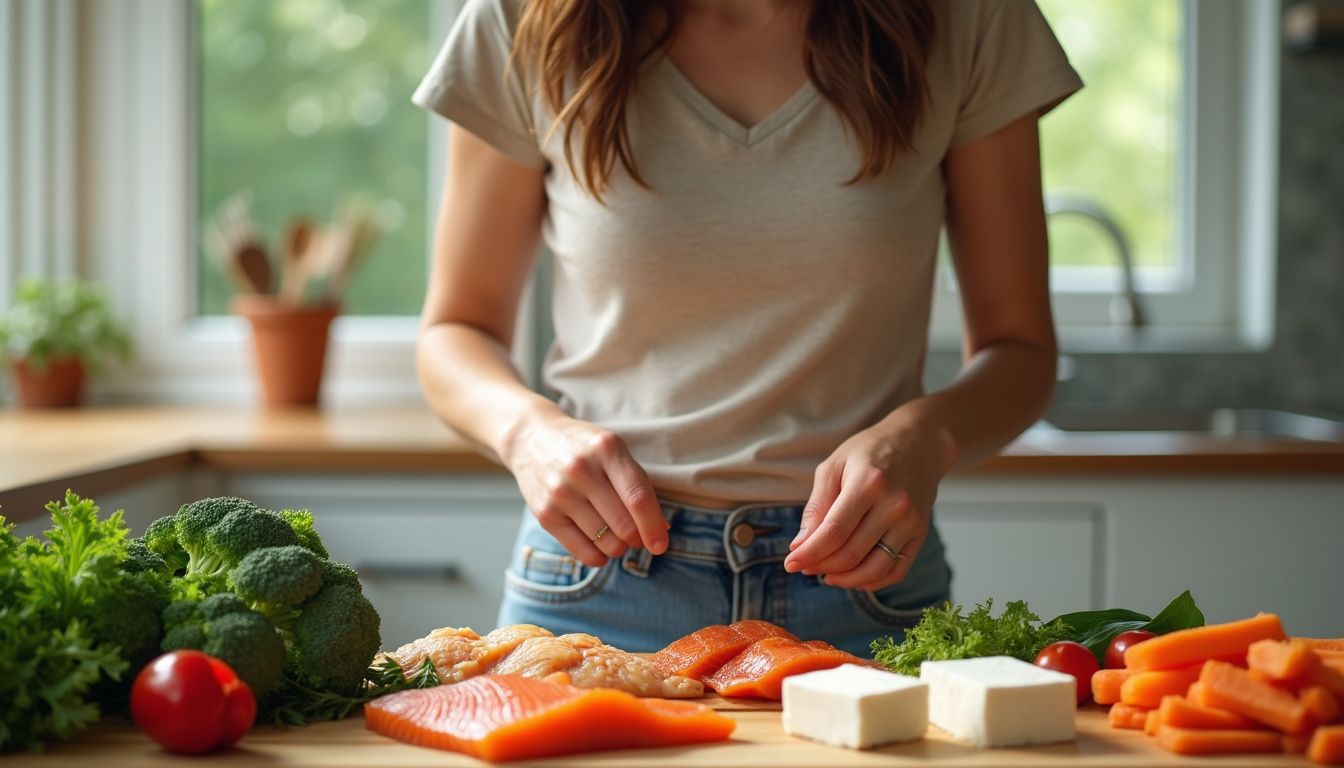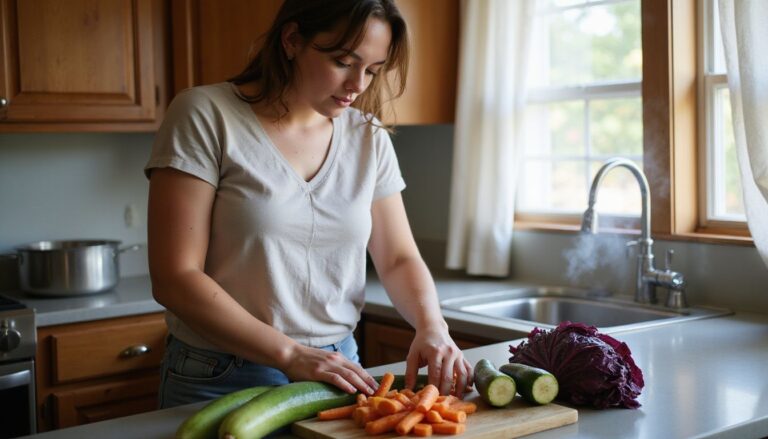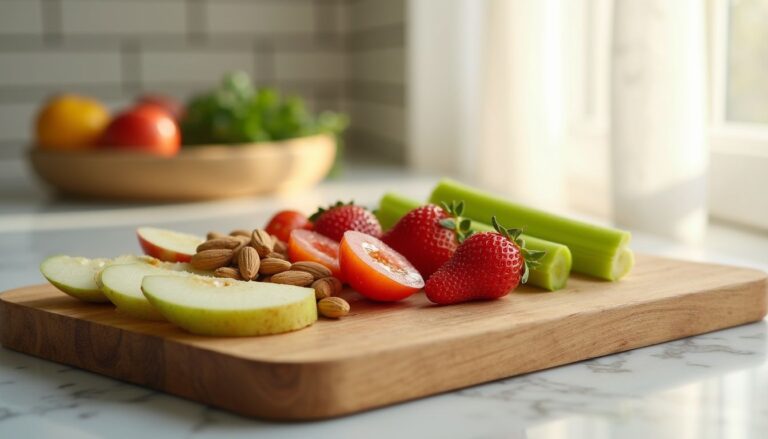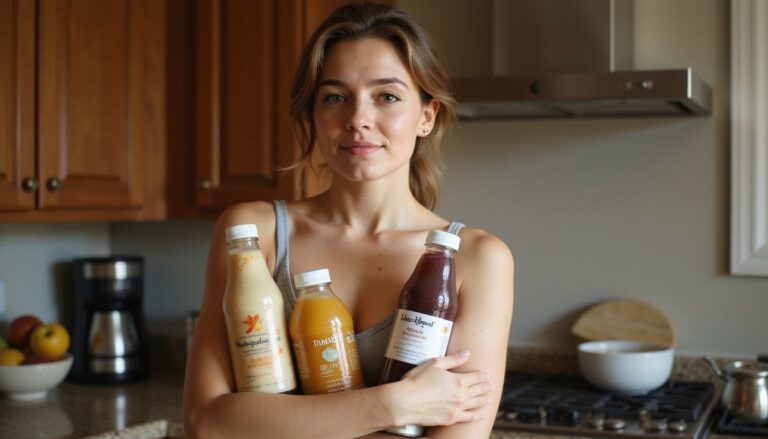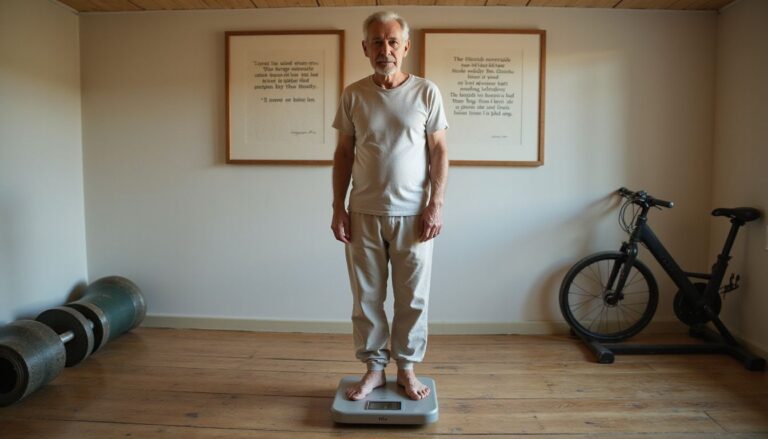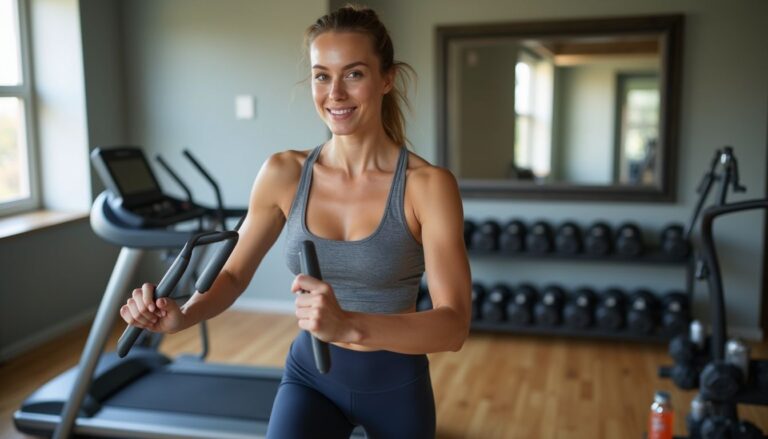Top 7 High-Protein Low Calorie Foods For Weight Loss
Our Nutrition Assistant AI Suite will transform your body. You will lose fat, get toned, and build muscle. Gain confidence and optimal health.
If losing weight or managing hunger feels hard, the right food choices can help. Research shows that choosing high-protein, low-calorie foods increases fullness and supports a steady eating plan for weight loss.
This guide highlights seven protein-rich foods that are low in calories, easy to find, and simple to use in meals and snacks. Keep reading for practical picks that fit real life.
Key Takeaways
- Skinless chicken breast, turkey breast, egg whites, non-fat Greek yogurt, white fish like cod or tilapia, tofu or edamame, and lentils or chickpeas deliver roughly 9–32 grams of protein per serving with under 210 calories.
- Higher protein intake improves fullness and helps preserve muscle during weight loss. Aim for at least 70–90 grams per day from lean or plant-based sources (Leidy HJ et al., 2015).
- Daily targets near 1,500 calories for women and 1,800 for men can support about one pound per week of weight loss when you center meals on low-calorie, high-protein foods (USDA, 2020–2025).
- Limit processed proteins. Pair lean choices with fiber-rich produce to keep sodium and saturated fat in check while covering key vitamins and minerals.
- Drink at least eight cups of water daily. Protein digestion creates extra nitrogen waste, so hydration supports healthy kidney function.
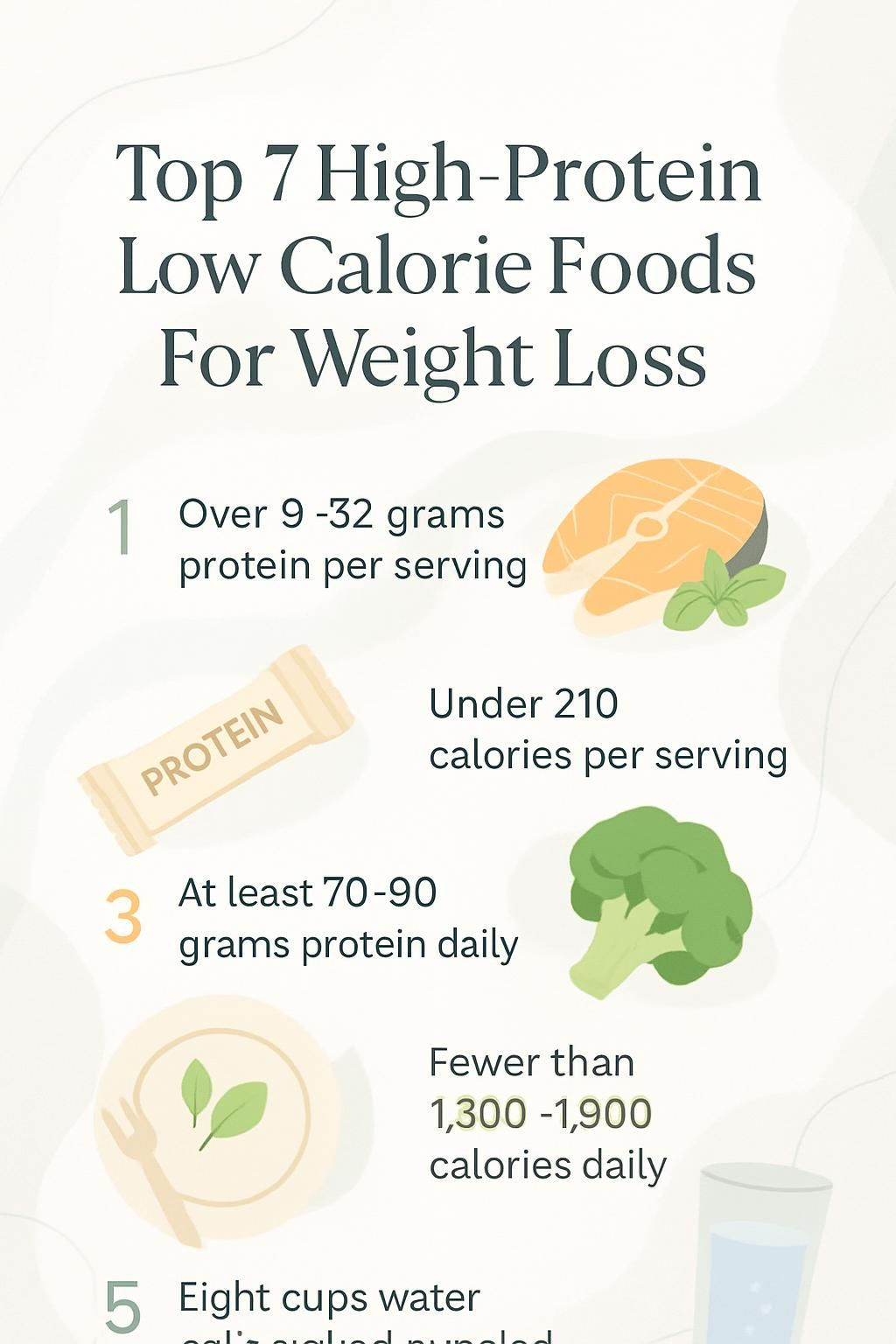
Why Choose High-Protein, Low-Calorie Foods for Weight Loss?
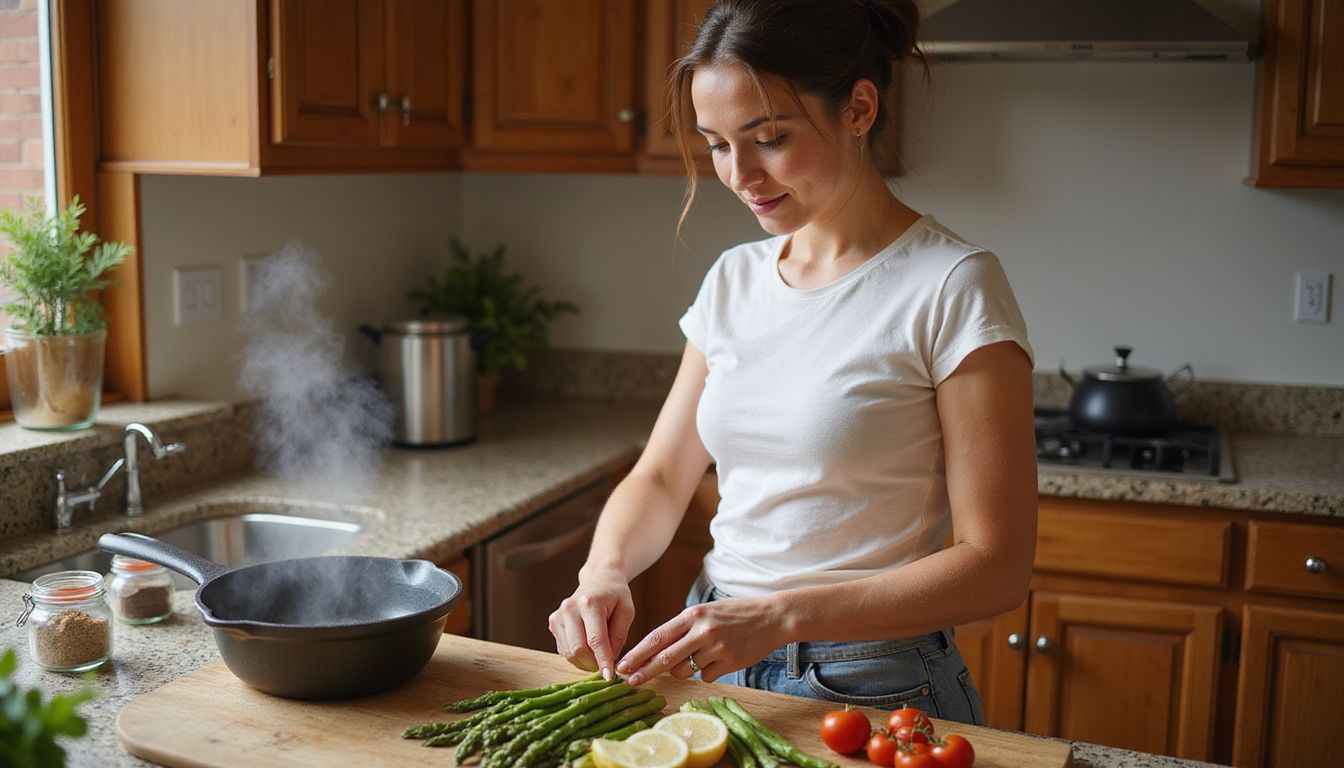
High-protein and low-calorie foods make weight loss easier because they keep you fuller with fewer calories. A balanced plate with more protein often feels satisfying, which can help you stay consistent.
How does protein help with weight management?
Protein increases satiety, the feeling of fullness after you eat. A 2016 meta-analysis published in the Journal of the Academy of Nutrition and Dietetics found that higher protein diets improve fullness and curb hunger between meals (doi:10.1016/j.jand.2016.01.003).
Foods rich in protein, like skinless chicken breast, Greek yogurt, egg whites, and lentils, digest more slowly than simple carbohydrates. That slower digestion helps steady energy and appetite.
Getting enough protein at each meal also helps protect lean muscle while you eat fewer calories. Preserving muscle supports your metabolism, which can help you keep weight off.
Spreading protein across four or five smaller meals can reduce snack cravings. Lean meats and plant-based protein, such as tofu and edamame, work well for this approach.
Adding extra protein kept me satisfied through busy afternoons, so I skipped sugary snacks,one reader shared after swapping a light lunch for a protein-focused meal.
Smaller, protein-forward meals can help you manage appetite and stick to your plan with less effort.
Why is reducing calorie intake important?
Reducing calories is essential for weight loss and better health. Cutting about 500 calories per day usually leads to a loss of about one pound per week.
The U.S. Department of Agriculture suggests a daily intake near 1,500 calories for many women and around 1,800 for many men during weight loss. Your exact needs depend on size, age, and activity.
Low-calorie foods let you eat satisfying portions without overeating. Fruits and vegetables have low energy density, which means fewer calories per bite due to high water and fiber.
For example, a small order of fries near 250 calories has a similar calorie count to ten cups of spinach plus one and a half cups of strawberries and a small apple. A cup of grapes has about 104 calories, while a cup of raisins has about 480 because the water is removed.
Choosing foods lower in fat and limiting calorie-dense snacks supports your goals and still provides vitamins and minerals you need each day.
Benefits of High-Protein, Low-Calorie Foods
These foods help control hunger, protect muscle, and support a steady calorie deficit. Think of protein as a steady anchor for your appetite and your metabolism.
How do these foods promote fullness and reduce hunger?
Protein-rich foods, such as turkey breast, Greek yogurt, and lentils, slow digestion and trigger hormones that signal fullness to your brain. The 2016 meta-analysis cited above supports this effect in both short and long time frames.
Snacks with at least 10 grams of protein, like cottage cheese or hard-boiled eggs, often reduce between-meal hunger.
Beans and other legumes give you both protein and dietary fiber. Fiber increases stomach volume with very few calories. Foods with higher water content, like tofu and Greek yogurt, also add volume and help you feel satisfied.
In my own kitchen, swapping ground beef for lean ground turkey or white fish kept me full longer with fewer calories and less fat.
Why is muscle preservation important during weight loss?
Losing muscle can slow your metabolism, which makes further weight loss harder. Preserving muscle helps you burn more calories, even while resting.
Lean proteins like skinless chicken breast, cod, and egg whites support muscle maintenance during a calorie deficit. Low-protein diets over time can cause greater muscle loss and reduced strength.
Include complete protein, which means it has all essential amino acids your body cannot make. Poultry, fish, eggs, dairy, soy, and a mix of plant proteins can meet this need.
When I switched my afternoon snack to a Greek yogurt parfait, about 20 grams of protein, my energy stayed steady compared to lower-protein routines.
How can high-protein foods boost metabolism?
Protein has a higher thermic effect of food than fat or carbohydrates. Your body burns more calories digesting protein. A serving of grilled chicken breast or non-fat Greek yogurt can raise post-meal calorie burn.
Protein supports lean muscle, and muscle uses more energy at rest than fat tissue. Keeping protein high helps you maintain your resting calorie burn while you lose weight.
Aim for roughly 70 grams of protein per day from whole food sources like eggs, legumes, tofu, seafood, and low-fat dairy. Spreading protein across meals can keep energy steadier than saving it all for dinner.
Simple ideas help. Try hard-boiled eggs with breakfast or roasted chickpeas as a snack. Both are rich in essential amino acids, the building blocks of protein that your body needs for repair and growth.
Tips for Incorporating High-Protein, Low-Calorie Foods into Your Diet
Small, steady changes add up. Plan ahead, choose lean proteins, and make cooking methods work for you.
How can I plan and prepare meals with high-protein, low-calorie foods?
Create a weekly plan that highlights a lean protein at each meal. Good options include skinless chicken breast, turkey breast, tofu, and white fish.
For dinner, pair 3 ounces of baked chicken with roasted vegetables. That serving offers about 26 grams of protein with very little saturated fat. Cook extra for quick lunches.
Batch-cook staples like ground turkey, chickpeas, quinoa, and hard-boiled eggs. Use them in tacos, stuffed peppers, grain bowls, and salads.
Keep protein snacks on hand, such as Greek yogurt with berries or roasted chickpeas. If needed, use protein powder to help you reach 70–90 grams per day, especially around workouts.
How do I balance protein with other nutrients?
Pair protein with fiber-rich carbohydrates like whole grains, beans, leafy greens, and fruit. Add small portions of healthy fats from nuts, seeds, and olive oil to support hormones and vitamin absorption.
Limit saturated fat to under 10 percent of calories. Choose lean proteins such as skinless chicken breast, turkey breast, tuna packed in water, or non-fat Greek yogurt.
Pick protein sources that deliver vitamins and minerals. Greek yogurt offers calcium and potassium. Lentils provide iron and magnesium. Choose unprocessed meats more often than processed options to avoid extra sodium and added sugars.
Rotate animal and plant proteins. Tofu, chickpeas, and lentils pair well with grains and veggies for complete nutrition. Easy snacks include cottage cheese with tomatoes or roasted chickpeas.
What are healthy cooking methods for protein-rich foods?
Method matters. Choose baking, broiling, grilling, poaching, steaming, or air frying to keep calories and saturated fat low while preserving protein.
- Bake, broil, or grill skinless chicken breast. One serving still gives about 27 grams of protein with little added fat.
- Use a pressure cooker or air fryer for chicken or turkey breast to limit oil.
- Steam or bake cod, tilapia, or halibut with herbs and lemon. Skip frying to keep calories lower.
- Stir-fry tofu or edamame in a teaspoon of olive oil for a quick, nutrient-dense meal.
- Boil or poach eggs instead of frying in butter to reduce added fat.
- Roast chickpeas at 400°F until crisp for a crunchy protein snack rich in minerals like selenium and zinc.
- Cook lentils in low-sodium broth. Choose brothy soups instead of creamy ones to save calories.
Avoid deep-frying red meat, pork cutlets, or breaded fish. Simple techniques bring flavor without unnecessary calories.
Top 7 High-Protein, Low-Calorie Foods for Weight Loss
These picks help you meet your protein goal with fewer calories. They fit easily into high-protein meals for weight management.
Skinless Chicken Breast
Skinless chicken breast offers about 32 grams of protein and only 158 calories per 3.5-ounce, or 100-gram, serving. It is very low in saturated fat and contains almost no carbohydrates.
Cooking methods like baking, broiling, grilling, pressure cooking, or air frying keep calories in check while adding flavor. A typical 3-ounce portion provides about 26 grams of protein, which supports muscle during a calorie deficit.
Use grilled chicken in salads, wraps, sheet pan meals, or grain bowls. Turkey breast provides similar benefits and variety.
Turkey Breast
Turkey breast is another lean meat with high protein. A 3.5-ounce serving has about 30 grams of protein, 147 calories, and only about 2 grams of fat.
It also supplies zinc, selenium, choline, and vitamin B12, which support immunity and energy. Trim visible fat to keep calories low. Bake, grill, or roast for meal prep.
Add slices to sandwiches, toss into salads, or serve with roasted vegetables. This is an easy way to keep protein high and calories low.
Egg Whites
Egg whites deliver most of an egg’s protein with almost no fat. Two large whole eggs give about 12 grams of protein and 143 calories, but using just the whites cuts calories and fat sharply.
An easy combo is one whole egg plus two egg whites. That mix gives roughly 13.5 grams of protein for about 106 calories and under 5 grams of fat.
Egg whites are cholesterol-free, which helps if you watch heart health. Scramble with peppers and spinach for a quick breakfast. Omelets with tomatoes and a pinch of cinnamon add flavor without many calories.
You can also swap egg whites for whole eggs in baking to lower saturated fat and total calories.
Greek Yogurt (Non-fat)
Non-fat Greek yogurt has about 16 grams of protein and roughly 92 calories per 5.5 ounces, or 156 grams. Each serving has less than one gram of fat.
The thick texture increases fullness compared to regular yogurt. It is rich in calcium, phosphorus, potassium, and selenium for bone and muscle support.
Use it as a stand-in for sour cream in dips or dressings to save calories. Blend with berries for a quick parfait or add to smoothies for extra creaminess and protein.
White Fish (Cod, Tilapia, Halibut)
White fish like cod, tilapia, and halibut offer lean protein at a low calorie cost. A 3.5-ounce serving provides about 19 grams of protein, only 134 calories, and around 6 grams of fat.
These fish also contribute vitamin D, selenium, vitamin B12, magnesium, and phosphorus. Grilling or baking helps retain nutrients and limits added fat.
Use white fish in tacos, salads, or simple baked dishes with herbs and lemon. Cod and tilapia are often budget-friendly and easy to find, which makes meal planning easier.
Tofu and Edamame
Tofu and edamame are excellent plant-based protein choices. A half cup of tofu, about 126 grams, provides around 21.8 grams of protein and 181 calories with mostly unsaturated fat.
Tofu supplies minerals like calcium, manganese, copper, and selenium for bone and cell health. One cup of shelled edamame has more than 18 grams of protein and about 188 calories, plus fiber and iron.
Both are cholesterol-free since they come from soybeans. Add to stir-fries, soups, and salads, or enjoy as snacks. They fit vegetarian plans and help you meet daily protein targets.
Lentils and Chickpeas
Lentils and chickpeas add affordable variety to your protein rotation. A half cup of cooked lentils has about 9 grams of protein with modest calories.
One cup of roasted chickpeas provides about 10.7 grams of protein, 210 calories, and roughly 9.6 grams of fiber. That mix of protein and fiber promotes fullness and steady energy.
Both offer important nutrients, including manganese, phosphorus, vitamin B6, and folate. These support heart health and stable blood sugar.
Keep canned chickpeas and dry lentils on hand for soups, salads, and curries. Roasted chickpeas make a crunchy snack that can replace chips.
Meal Ideas Featuring High-Protein, Low-Calorie Foods
These simple recipes turn the foods above into tasty, high-protein meals. They also work well for weekly meal prep.
What are some easy meals with grilled chicken and vegetables?
Grill a skinless chicken breast and serve it with roasted broccoli, peppers, and carrots. One serving of lean grilled chicken offers about 26 to 32 grams of protein with a low calorie count.
Use spice blends instead of heavy sauces to keep sodium and calories low. For a time-saving option, make a sheet pan dinner with diced chicken and mixed vegetables.
Try a quick stir-fry with chicken, colorful vegetables, and cauliflower rice or quinoa. These meals support portion control, help you meet protein goals, and keep your plan simple.
How do I make a Greek yogurt parfait with berries?
Spoon 5.5 ounces, or 156 grams, of non-fat Greek yogurt into a bowl. Add a layer of fresh berries such as blueberries, strawberries, or raspberries for fiber and vitamin C.
Top with a small sprinkle of granola for crunch and a few chopped nuts for healthy fats. Non-fat Greek yogurt gives about 16 grams of protein with only around 92 calories.
Berries add natural sweetness, so extra sugar is not needed. Enjoy this parfait for breakfast or as a protein snack.
What is a simple lentil soup recipe with fresh herbs?
Pour 4 cups of low-sodium broth into a pot and bring it to a simmer. Sauté chopped onions, carrots, and celery in a little olive oil until soft, then season with garlic powder, cumin, and black pepper.
Add 1 cup of pre-cooked lentils. Lentils offer about 9 grams of protein per half cup plus fiber for gut health. Simmer for 10 minutes so flavors blend.
Stir in chopped parsley or cilantro before serving to brighten taste and color. This soup stores well in the fridge or freezer for fast meals.
How can I prepare a tofu stir-fry with broccoli and carrots?
Press tofu to remove moisture, then cut into cubes. Use about a half cup, or 126 grams, per serving for roughly 21.8 grams of protein and about 181 calories.
Heat a nonstick pan with a tablespoon of olive or canola oil. Stir-fry tofu until golden, then add sliced broccoli and carrots. Cook until crisp-tender, about four minutes.
Season with low-sodium soy sauce or garlic and ginger. Tofu is cholesterol-free and supplies minerals like calcium and manganese, which makes it a quick, nutrient-dense weeknight option.
What is a healthy baked white fish dish with quinoa and lemon?
Bake a 3.5-ounce fillet of cod, tilapia, or halibut with lemon slices and herbs like dill or parsley. That serving provides about 19 grams of protein and around 134 calories.
Serve it over cooked quinoa to add fiber and a bit more protein. The meal supplies vitamin D, selenium, and vitamin B12 for overall health.
This simple dish supports muscle maintenance while you keep calories under control. It also gives you variety beyond chicken or egg whites.
Additional High-Protein, Low-Calorie Snacks
Smart snacks prevent energy dips and reduce cravings. These three options are portable, affordable, and filling.
Are hard-boiled eggs a good low-calorie snack?
Hard-boiled eggs are convenient and satisfying. One large egg has about 6 grams of protein and around 72 calories. Two eggs provide over 12 grams of protein for roughly 143 calories.
Egg whites are even lower in calories and fat. Eggs also supply vitamin D, choline, phosphorus, and vitamin A.
Cook a batch for the week so you have grab-and-go protein. Many athletes use them after workouts to support muscle recovery without adding many calories.
How can cottage cheese with diced tomatoes be a healthy snack?
Cottage cheese with tomatoes delivers a protein-rich, low-calorie combo. A half cup of low-fat cottage cheese offers about 14 grams of protein for under 90 calories.
Tomatoes add vitamin C and water, which lowers calorie density. Cottage cheese also provides calcium, selenium, vitamin B12, phosphorus, and riboflavin.
Season with black pepper, chili flakes, or fresh herbs. This savory snack keeps afternoon hunger in check without much prep.
What are the benefits of roasted chickpeas as a snack?
Roasted chickpeas are a crunchy plant-based choice. One cup provides about 10.7 grams of protein, 210 calories, and 9.6 grams of fiber.
They are gluten-free and low in saturated fat, and they deliver vitamin B6, folate, manganese, and phosphorus. Change seasonings for variety, such as smoked paprika, cumin, or lemon pepper.
Unlike chips or crackers, roasted chickpeas bring both protein and fiber. They help sustain energy and make it easier to follow your eating plan.
Common Mistakes to Avoid When Following a High-Protein Diet
A high-protein diet can be effective, yet a few missteps can slow progress. Spot these early to stay on track.
Why should I not ignore other essential nutrients?
Focusing only on protein and skipping other nutrients can harm health and stall weight loss. Healthy carbohydrates from fruits, vegetables, whole grains, beans, and low-fat dairy give you steady energy.
Fiber supports gut health and metabolism. Chickpeas and other legumes deliver both protein and fiber, which is a powerful combo for fullness.
Healthy fats from nuts, seeds, olive oil, and fish aid brain function and help absorb vitamins A, D, E, and K. A varied plate prevents nutrient gaps that can sap energy and mood.
What are the risks of overeating protein-rich processed foods?
Protein-rich processed foods often have high sodium, sometimes over 300 milligrams per serving, which can raise blood pressure. Some products add sugar, like certain flavored yogurts or protein bars, which increases calories quickly.
Many processed meats contain saturated fat that has been linked to heart disease. These items can also crowd out fiber-rich whole foods, which reduces overall diet quality.
I relied on packaged protein bars during hectic weeks and felt sluggish. When I chose grilled chicken or a homemade lentil soup instead, I had better energy.
U.S. Dietary Guidelines suggest limiting highly processed foods to reduce extra calories and improve long-term health.
How much water should I drink on a high-protein diet?
Protein metabolism creates nitrogen waste, which your kidneys must clear. Drinking enough water helps your kidneys do this job well.
Aim for at least 8 to 10 cups of water per day. Larger bodies, higher activity, or higher protein intake may require more.
Hydration also helps manage appetite and supports digestion. You can boost fluid intake with water-rich foods like fruit and vegetables at meals.
How to Sustain a High-Protein, Low-Calorie Diet for Long-Term Weight Loss
Consistency beats intensity. Build routines that fit your life, then adjust as your needs change.
How can I make gradual changes to my diet habits?
Start small. Swap processed snacks for Greek yogurt, roasted chickpeas, or a handful of nuts. Add lean protein like chicken breast, tofu, and legumes to more meals each week.
Watch portions to manage calorie intake. I replaced late-night chips with non-fat Greek yogurt and noticed fewer cravings and better sleep.
Test simple recipes until you find reliable favorites. Remove one high-calorie processed item from your cart each week. Prep meals ahead so your plan survives busy days.
Why is tracking progress important and how do I adjust my diet?
Tracking shows if you hit targets, such as 70 to 90 grams of protein and your calorie goal. Food logs and nutrition apps reveal patterns, nutrient gaps, and triggers for overeating.
Weigh yourself weekly or use body composition checks to track trends in fat loss and muscle. If hunger rises or weight plateaus, adjust meal timing, portions, or protein sources.
Brief check-ins with a healthcare professional can set realistic targets and guide small changes that stick.
When should I consult a nutritionist for personalized advice?
Seek a registered dietitian if you have health conditions, food allergies, or special dietary needs. Professional guidance helps you find safe calorie and protein targets and a meal plan you enjoy.
Persistent fatigue, digestive trouble, or signs of nutrient gaps are red flags. Expert support keeps protein high, calories appropriate, and nutrients balanced.
Conclusion
Choosing high-protein, low-calorie foods can help with weight loss and fitness. These foods increase fullness, support muscle, and keep calorie intake in line with your goals.
Skinless chicken breast, non-fat Greek yogurt, egg whites, white fish, tofu, edamame, lentils, and chickpeas are reliable protein sources that are low in calories. Evidence shows higher protein intake helps preserve lean mass while you lose weight [1][2].
Build steady habits with meal planning and a short list of go-to recipes. If you have medical conditions or take medications, ask a healthcare professional for personalized advice. This article is for education, not a substitute for medical care.
References:
[1] U.S. Department of Agriculture Dietary Guidelines, 2020–2025
[2] Leidy HJ et al., American Journal of Clinical Nutrition, 2015
FAQs
1. What are the top 7 high-protein low calorie foods for weight loss?
The most effective options include chicken breast, Greek yogurt, egg whites, cottage cheese, cod fillet, tofu, and lentils. Each food offers a strong protein content with fewer calories per serving. For example, three ounces of chicken breast provide about 26 grams of protein and only 128 calories according to USDA data.
2. How do these foods help with weight loss?
High-protein low calorie foods support muscle retention while reducing hunger during calorie restriction. Research from the American Journal of Clinical Nutrition shows that higher protein intake can increase satiety and preserve lean mass when losing weight.
3. Can I eat these foods every day as part of my diet plan?
Yes; rotating these items in your meals helps ensure variety and balanced nutrition. Including different sources like dairy products or legumes also supplies vitamins and minerals needed for health.
4. Are there risks if I rely only on high-protein low calorie foods?
Focusing solely on one group may limit essential nutrients found in other food categories such as fruits or whole grains. A registered dietitian recommends combining proteins with vegetables and healthy fats for long-term success.
Summary: High-protein low calorie choices like poultry meat or plant-based proteins aid fat loss by curbing appetite without excess energy intake. Balanced meal planning ensures you receive all necessary nutrients while working toward your goals.

